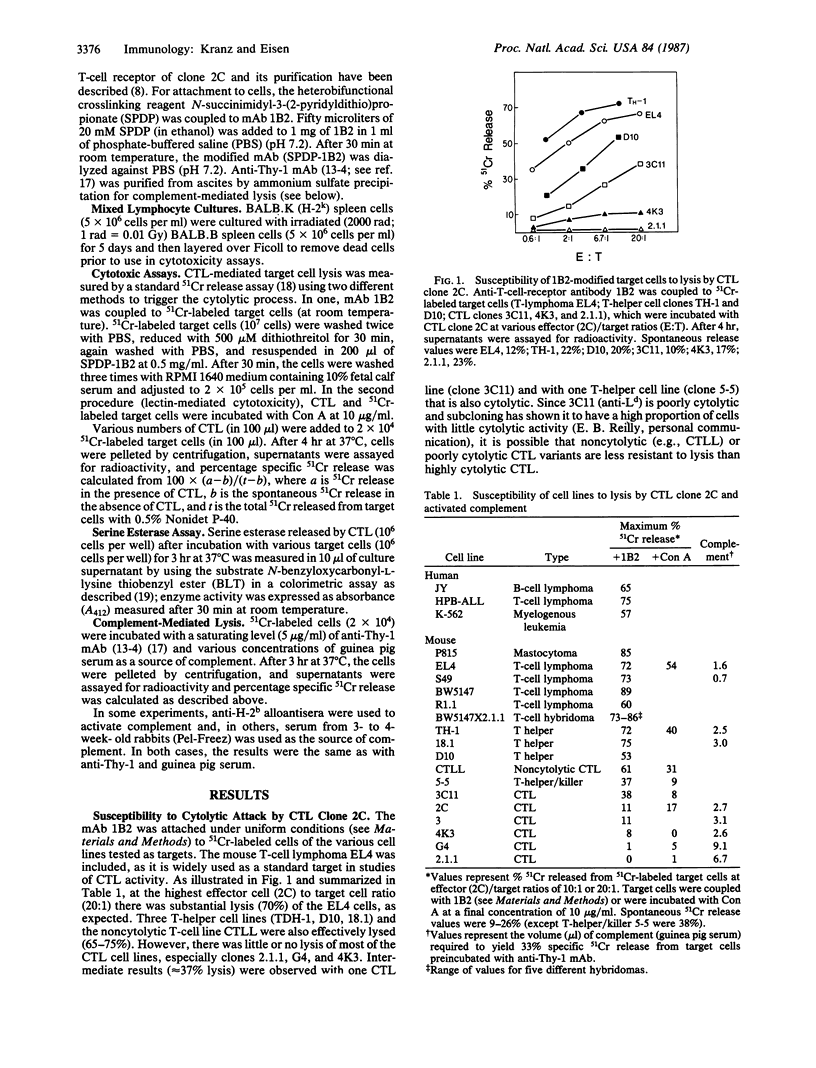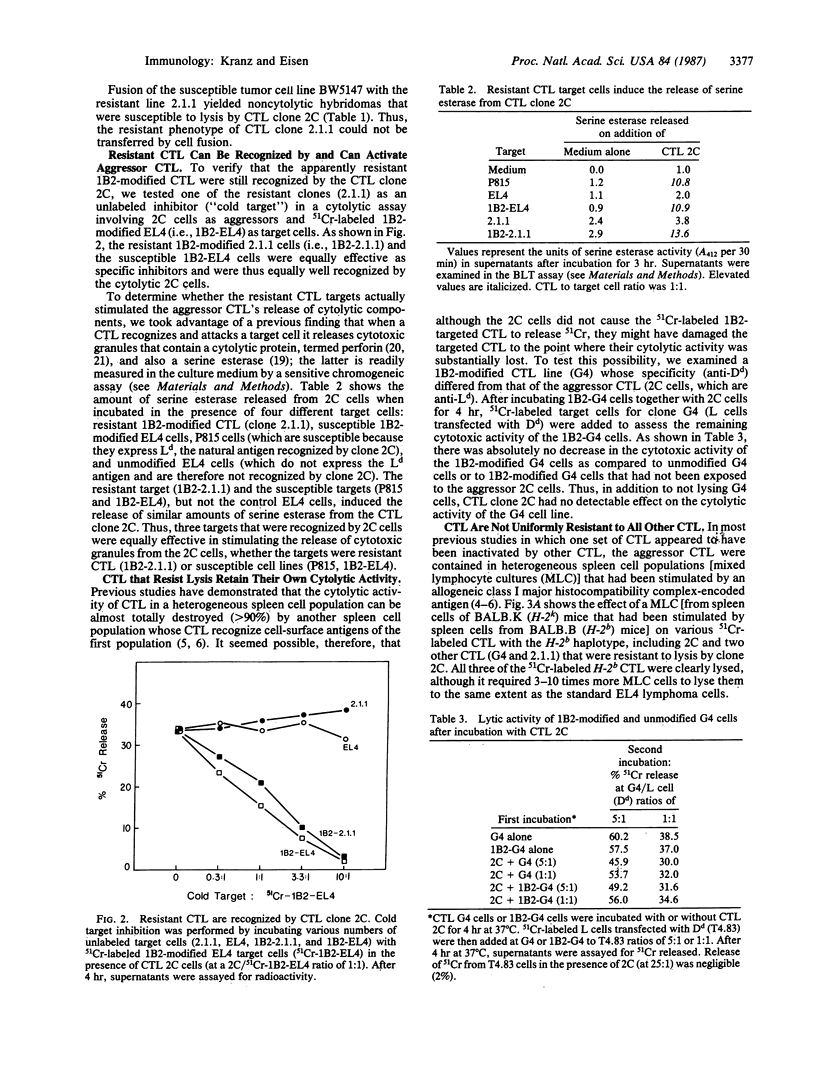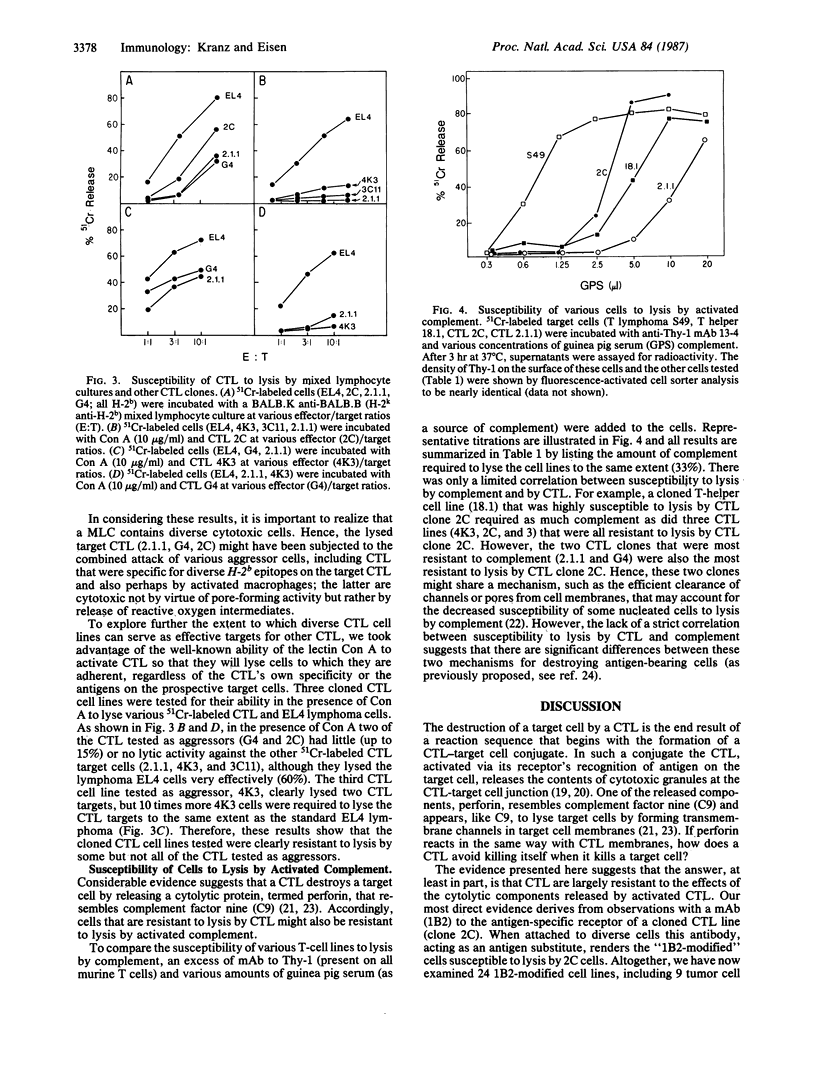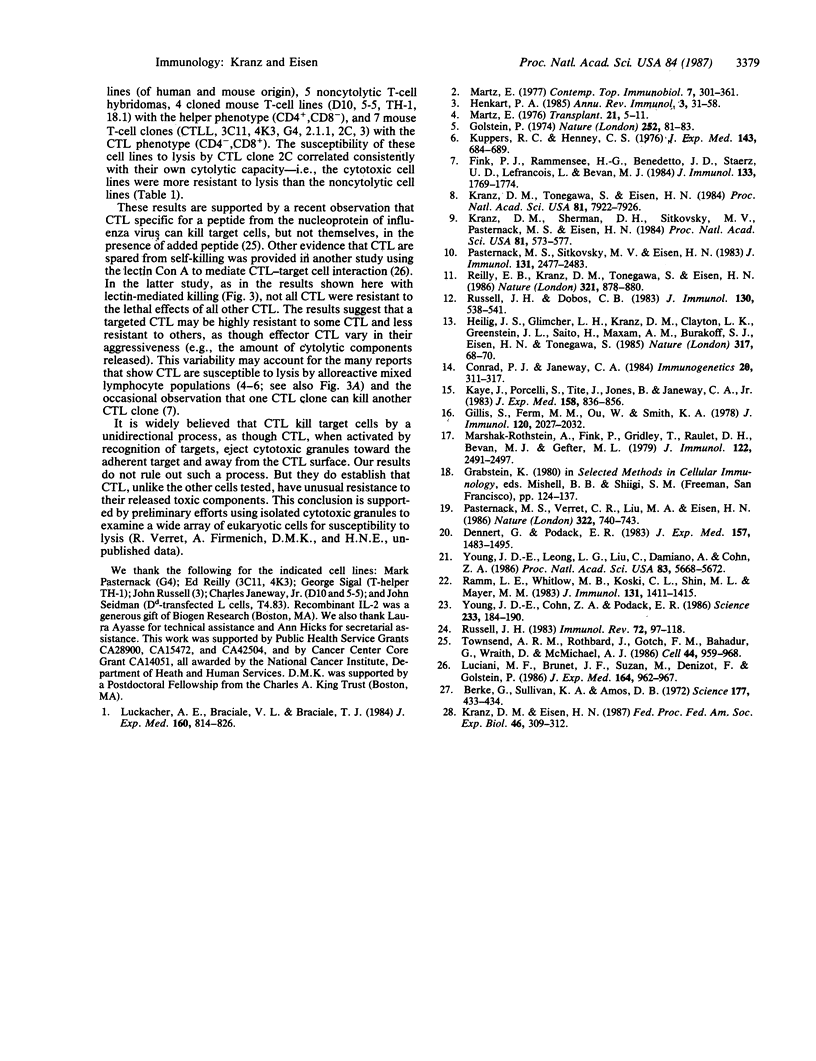Abstract
To investigate how cytotoxic T lymphocytes (CTL) avoid killing themselves when they destroy target cells, we compared 20 different cell lines as target cells, including several CTL cell lines, for their susceptibility to lysis by CTL. Variations in recognition of this diverse set of target cells was circumvented by attaching to all of them a monoclonal antibody to the antigen-specific receptor of a cloned CTL cell line (clone 2C) and using the 2C cell line as the standard aggressor or effector cell. All of the nine tumor cell lines and the four noncytolytic T-helper cell lines tested as targets were highly susceptible to lysis by the aggressor CTL, but seven cytotoxic T-cell lines (six CTL and one T-helper cell line with cytotoxic activity) were largely resistant. These results, and the use of the lectin Con A as an alternative means for triggering CTL activity, point clearly to a level of resistance that could enable CTL to avoid their own destruction when they lyse target cells. The resistance of the cytolytic T cells did not appear to be accompanied by a similar resistance to complement-mediated lysis, indicating that mechanisms of CTL-mediated and complement-mediated lysis are not identical.
Full text
PDF




Selected References
These references are in PubMed. This may not be the complete list of references from this article.
- Berke G., Sullivan K. A., Amos D. B. Tumor immunity in vitro: destruction of a mouse ascites tumor through a cycling pathway. Science. 1972 Aug 4;177(4047):433–434. doi: 10.1126/science.177.4047.433. [DOI] [PubMed] [Google Scholar]
- Conrad P. J., Janeway C. A., Jr The expression of I-Ed molecules in F1 hybrid mice detected with antigen-specific, I-Ed-restricted cloned T-cell lines. Immunogenetics. 1984;20(3):311–319. doi: 10.1007/BF00364212. [DOI] [PubMed] [Google Scholar]
- Dennert G., Podack E. R. Cytolysis by H-2-specific T killer cells. Assembly of tubular complexes on target membranes. J Exp Med. 1983 May 1;157(5):1483–1495. doi: 10.1084/jem.157.5.1483. [DOI] [PMC free article] [PubMed] [Google Scholar]
- Fink P. J., Rammensee H. G., Benedetto J. D., Staerz U. D., Lefrancois L., Bevan M. J. Studies on the mechanism of suppression of primary cytotoxic responses by cloned cytotoxic T lymphocytes. J Immunol. 1984 Oct;133(4):1769–1774. [PubMed] [Google Scholar]
- Gillis S., Ferm M. M., Ou W., Smith K. A. T cell growth factor: parameters of production and a quantitative microassay for activity. J Immunol. 1978 Jun;120(6):2027–2032. [PubMed] [Google Scholar]
- Golstein P. Sensitivity of cytotoxic T cells to T-cell mediated cytotoxicity. Nature. 1974 Nov 1;252(5478):81–83. doi: 10.1038/252081a0. [DOI] [PubMed] [Google Scholar]
- Heilig J. S., Glimcher L. H., Kranz D. M., Clayton L. K., Greenstein J. L., Saito H., Maxam A. M., Burakoff S. J., Eisen H. N., Tonegawa S. Expression of the T-cell-specific gamma gene is unnecessary in T cells recognizing class II MHC determinants. Nature. 1985 Sep 5;317(6032):68–70. doi: 10.1038/317068a0. [DOI] [PubMed] [Google Scholar]
- Henkart P. A. Mechanism of lymphocyte-mediated cytotoxicity. Annu Rev Immunol. 1985;3:31–58. doi: 10.1146/annurev.iy.03.040185.000335. [DOI] [PubMed] [Google Scholar]
- Kaye J., Porcelli S., Tite J., Jones B., Janeway C. A., Jr Both a monoclonal antibody and antisera specific for determinants unique to individual cloned helper T cell lines can substitute for antigen and antigen-presenting cells in the activation of T cells. J Exp Med. 1983 Sep 1;158(3):836–856. doi: 10.1084/jem.158.3.836. [DOI] [PMC free article] [PubMed] [Google Scholar]
- Kranz D. M., Pasternack M. S., Eisen H. N. Recognition and lysis of target cells by cytotoxic T lymphocytes. Fed Proc. 1987 Feb;46(2):309–312. [PubMed] [Google Scholar]
- Kranz D. M., Sherman D. H., Sitkovsky M. V., Pasternack M. S., Eisen H. N. Immunoprecipitation of cell surface structures of cloned cytotoxic T lymphocytes by clone-specific antisera. Proc Natl Acad Sci U S A. 1984 Jan;81(2):573–577. doi: 10.1073/pnas.81.2.573. [DOI] [PMC free article] [PubMed] [Google Scholar]
- Kranz D. M., Tonegawa S., Eisen H. N. Attachment of an anti-receptor antibody to non-target cells renders them susceptible to lysis by a clone of cytotoxic T lymphocytes. Proc Natl Acad Sci U S A. 1984 Dec;81(24):7922–7926. doi: 10.1073/pnas.81.24.7922. [DOI] [PMC free article] [PubMed] [Google Scholar]
- Luciani M. F., Brunet J. F., Suzan M., Denizot F., Golstein P. Self-sparing of long-term in vitro-cloned or uncloned cytotoxic T lymphocytes. J Exp Med. 1986 Sep 1;164(3):962–967. doi: 10.1084/jem.164.3.962. [DOI] [PMC free article] [PubMed] [Google Scholar]
- Lukacher A. E., Braciale V. L., Braciale T. J. In vivo effector function of influenza virus-specific cytotoxic T lymphocyte clones is highly specific. J Exp Med. 1984 Sep 1;160(3):814–826. doi: 10.1084/jem.160.3.814. [DOI] [PMC free article] [PubMed] [Google Scholar]
- Marshak-Rothstein A., Fink P., Gridley T., Raulet D. H., Bevan M. J., Gefter M. L. Properties and applications of monoclonal antibodies directed against determinants of the Thy-1 locus. J Immunol. 1979 Jun;122(6):2491–2497. [PubMed] [Google Scholar]
- Martz E. Mechanism of specific tumor-cell lysis by alloimmune T lymphocytes: resolution and characterization of discrete steps in the cellular interaction. Contemp Top Immunobiol. 1977;7:301–361. doi: 10.1007/978-1-4684-3054-7_9. [DOI] [PubMed] [Google Scholar]
- Pasternack M. S., Sitkovsky M. V., Eisen H. N. The site of action of N-alpha-tosyl-L-lysyl-chloromethyl-ketone (TLCK) on cloned cytotoxic T lymphocytes. J Immunol. 1983 Nov;131(5):2477–2483. [PubMed] [Google Scholar]
- Pasternack M. S., Verret C. R., Liu M. A., Eisen H. N. Serine esterase in cytolytic T lymphocytes. Nature. 1986 Aug 21;322(6081):740–743. doi: 10.1038/322740a0. [DOI] [PubMed] [Google Scholar]
- Ramm L. E., Whitlow M. B., Koski C. L., Shin M. L., Mayer M. M. Elimination of complement channels from the plasma membranes of U937, a nucleated mammalian cell line: temperature dependence of the elimination rate. J Immunol. 1983 Sep;131(3):1411–1415. [PubMed] [Google Scholar]
- Reilly E. B., Kranz D. M., Tonegawa S., Eisen H. N. A functional gamma gene formed from known gamma-gene segments is not necessary for antigen-specific responses of murine cytotoxic T lymphocytes. 1986 Jun 26-Jul 2Nature. 321(6073):878–880. doi: 10.1038/321878a0. [DOI] [PubMed] [Google Scholar]
- Russell J. H., Dobos C. B. Characterization of a "heteroclitic" cytotoxic lymphocyte clone: heterogeneity of receptors or signals? J Immunol. 1983 Feb;130(2):538–541. [PubMed] [Google Scholar]
- Russell J. H. Internal disintegration model of cytotoxic lymphocyte-induced target damage. Immunol Rev. 1983;72:97–118. doi: 10.1111/j.1600-065x.1983.tb01074.x. [DOI] [PubMed] [Google Scholar]
- Townsend A. R., Rothbard J., Gotch F. M., Bahadur G., Wraith D., McMichael A. J. The epitopes of influenza nucleoprotein recognized by cytotoxic T lymphocytes can be defined with short synthetic peptides. Cell. 1986 Mar 28;44(6):959–968. doi: 10.1016/0092-8674(86)90019-x. [DOI] [PubMed] [Google Scholar]
- Young J. D., Cohn Z. A., Podack E. R. The ninth component of complement and the pore-forming protein (perforin 1) from cytotoxic T cells: structural, immunological, and functional similarities. Science. 1986 Jul 11;233(4760):184–190. doi: 10.1126/science.2425429. [DOI] [PubMed] [Google Scholar]
- Young J. D., Leong L. G., Liu C. C., Damiano A., Cohn Z. A. Extracellular release of lymphocyte cytolytic pore-forming protein (perforin) after ionophore stimulation. Proc Natl Acad Sci U S A. 1986 Aug;83(15):5668–5672. doi: 10.1073/pnas.83.15.5668. [DOI] [PMC free article] [PubMed] [Google Scholar]


